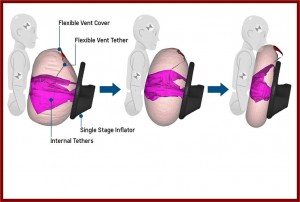The 2013 Chevrolet Cruze using a groundbreaking single inflator airbag has been rated by the National Highway Traffic Safety Administration at a maximum 5-Star Overall Vehicle Score. The development is potentially significant for car buyers because the 2013 Cruze model switched to a less expensive, more compact and lighter airbag design from Takata.
In an industry first, GM is using only one inflator for both low-speed crashes and high-speed ones. A flexible vent in the new design reduces the risk of inflation-induced injury by allowing the driver’s forward momentum to push the air out of the bag. GM said its testing shows the single-stage driver airbag provides excellent cushioning for drivers of varied sizes in both low-speed and high-speed accidents. More complex dual-stage airbags now in global use have two explosive devices to deploy the bag.
Cruze’s flexible venting driver airbag is the second new airbag technology GM has announced for 2013. The on Buick Enclave, GMC Acadia, and Chevrolet Traverse midsize crossovers introduced the industry’s first front center airbag. This inflatable restraint is designed to help protect drivers and front passengers in far-side impact crashes where the affected occupant is on the opposite, non-struck side of the vehicle. A GM analysis of the NHTSA’s Fatality Analysis Reporting System database (FARS) found that far-side impact crashes accounted for 11% of the belted front occupant fatalities in non-rollover impacts between 2004 and 2009. (General Motors to Debut World’s First Center Airbag in 2013)
The front center airbag explodes from the right side of the driver’s seat and then positions itself between the front row seats near the center of the vehicle. This tethered, tubular airbag is designed to provide restraint during passenger-side crashes when the driver is the only front occupant, and also acts as an energy-absorbing cushion between driver and front passenger in both driver- and passenger-side crashes. Takata is the supplier.
The non-vented airbag – meaning it stays inflated – also is expected to provide safety benefits in longer duration rollovers. These far-side fatalities involving 1999 model year or newer vehicles happened where the occupant was on the non-struck side of the vehicle. The data represent 29% of all the belted front occupant fatalities during side impacts.
Also implied in the data is the hypothesis that much more work remains to be done by automakers on interior design, including fixing seat belts that don’t hold an occupant laterally, fixing the now ubiquitous center consoles that are causing serious and fatal injuries, and redesigning the seat itself, which allows deadly movement in the first place. With intense engineering, some of these problems could be solved with passive solutions. This could be far less expensive than adding another airbag to every new vehicle. It could also be more effective for greater numbers of car buyers.



